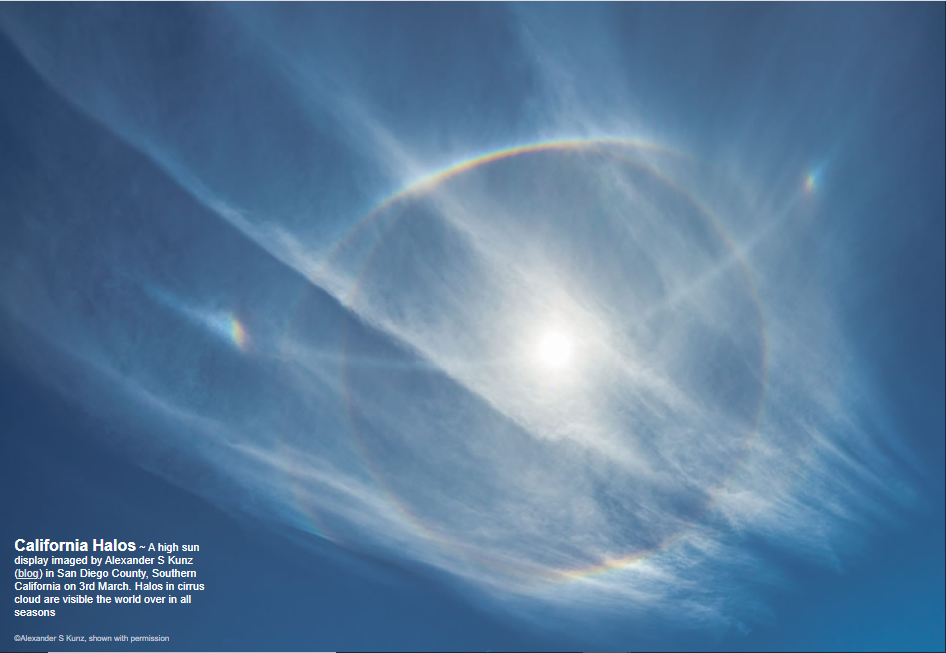California Halos - OPOD
California Halos - A Mesmerizing Atmospheric Phenomenon
California is known for its stunning landscapes and breathtaking natural phenomena. Among these wonders are the mesmerizing California Halos, which can be observed in the skies of San Diego County and other parts of Southern California. These halos, formed by cirrus clouds, are a captivating display that can be seen all year round.
Halos are optical phenomena caused by the interaction of sunlight with ice crystals suspended in the atmosphere. The California Halos feature two distinct halos encircling the high sun at an angle of 47°. Let's delve into the details of these captivating atmospheric optics:
The Inner Halo - A Familiar Sight
The inner halo is the well-known 22° radius halo, which appears as a truly circular ring around the sun. This halo is created by the refraction and reflection of sunlight within hexagonal ice crystals. It is a common occurrence worldwide and can be observed in all seasons. The 22° halo is often characterized by its vibrant colors, ranging from pale blues to vibrant reds.
The Outer Halo - A Unique Circumscribed Display
The outer halo, known as the circumscribed halo, surrounds the 22° halo and exhibits a less circular shape. It is particularly prominent when the sun is at an angle of less than 29°. At this angle, the circumscribed halo splits into upper and lower tangent arcs, giving it a distinctive appearance. This phenomenon is caused by horizontal hexagonal column crystals that generate the outer halo.
The Illusion of Pastel Colors
As the sun rises higher in the sky, the circumscribed halo becomes nearly circular and can often be mistaken for the more pastel-colored 22° halo. This optical illusion occurs due to the changing angles at which sunlight interacts with the ice crystals. The interplay of light and ice crystals creates a captivating display of colors, enhancing the beauty of the California Halos.
Parhelic Circle - A Parallel Wonder
Accompanying the California Halos is a bright parhelic circle that crosses the sun. This circular phenomenon appears parallel to the horizon, creating a captivating spectacle. In reality, the parhelic circle is not curved upwards, but the fisheye projection in images can create this illusion. The parhelic circle adds an extra layer of fascination to the already enchanting display of halos.
Sundogs - Distant Companions
Sundogs, also known as "22° parhelia," are another intriguing feature of the California Halos. These colorful spots of light appear far away from the sun, contrary to their name. Sundogs are only observed at a distance of 22° from the sun when it is on the horizon. These phenomena are caused by the refraction and reflection of sunlight by ice crystals in the atmosphere, creating a beautiful and ethereal sight.
The Magic of California Halos
The California Halos are a testament to the captivating beauty of atmospheric optics. They provide a glimpse into the wonders of nature and remind us of the intricate interactions between light and ice crystals in our atmosphere. Whether you're a seasoned sky-watcher or simply appreciating the beauty of the world around you, witnessing the California Halos is an awe-inspiring experience that should not be missed.
In conclusion, the California Halos are a stunning atmospheric phenomenon that grace the skies of Southern California. With their dual halos, pastel colors, and accompanying parhelic circle and sundogs, these halos offer a mesmerizing display for those fortunate enough to witness them. So next time you find yourself in California, remember to keep your eyes on the sky and marvel at the captivating beauty of the California Halos.

California Halos ~ A high sun display imaged by Alexander S Kunz (blog) in San Diego County, Southern California on 3rd March. Halos in cirrus cloud are visible the world over in all seasons
©Alexander S Kunz, shown with permission

Two halos encircle the 47° high sun.
The inner truly circular one is the familiar 22° radius halo.
The outer considerably less circular is the circumscribed halo. It touches the 22° halo above and below the sun. When the sun is less than 29° high it splits into upper and lower tangent arcs. Horizontal hexagonal column crystal generate it. At very high sun it becomes almost circular and is often mistaken for the more pastel coloured 22° halo.
A bright parhelic circle crosses the sun. It is parallel to the horizon. In the HaloSim ray tracing at right the fisheye projection makes it appear to curve upwards.
The sundogs or "22° parhelia" are far away from 22° from the sun. Sundogs are only at that distance when the sun is on the horizon.
Note: this article has been automatically converted from the old site and may not appear as intended. You can find the original article here.
Reference Atmospheric Optics
If you use any of the definitions, information, or data presented on Atmospheric Optics, please copy the link or reference below to properly credit us as the reference source. Thank you!
-
<a href="https://atoptics.co.uk/blog/california-halos-opod/">California Halos - OPOD</a>
-
"California Halos - OPOD". Atmospheric Optics. Accessed on April 16, 2024. https://atoptics.co.uk/blog/california-halos-opod/.
-
"California Halos - OPOD". Atmospheric Optics, https://atoptics.co.uk/blog/california-halos-opod/. Accessed 16 April, 2024
-
California Halos - OPOD. Atmospheric Optics. Retrieved from https://atoptics.co.uk/blog/california-halos-opod/.